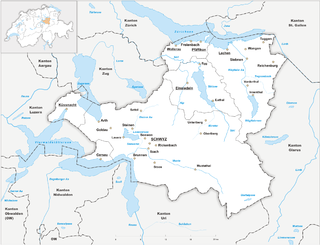
The canton of Schwyz is a canton in central Switzerland between the Alps in the south, Lake Lucerne to the west and Lake Zürich in the north, centred on and named after the town of Schwyz.

Unterwalden, translated from the Latin inter silvas, is the old name of a forest-canton of the Old Swiss Confederacy in central Switzerland, south of Lake Lucerne, consisting of two valleys or Talschaften, now two separate Swiss cantons, Obwalden and Nidwalden.

The 26 cantons of Switzerland are the member states of the Swiss Confederation. The nucleus of the Swiss Confederacy in the form of the first three confederate allies used to be referred to as the Waldstätte. Two important periods in the development of the Old Swiss Confederacy are summarized by the terms Acht Orte and Dreizehn Orte.
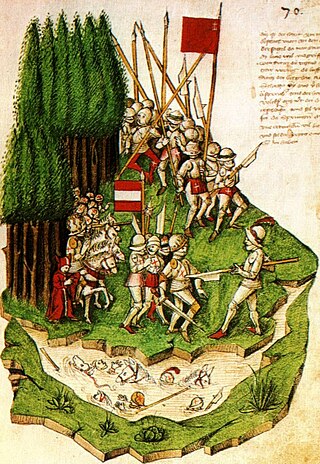
The Battle of Morgarten took place on 15 November 1315, when troops of Schwyz, supported by their allies of Uri and Unterwalden, ambushed an Austrian army under the command of Leopold I, Duke of Austria on the shores of Lake Ägeri, in the territory of Schwyz.
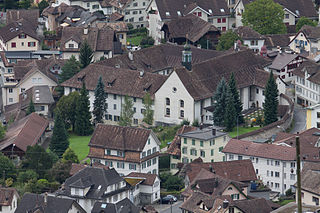
Schwyz is a town and the capital of the canton of Schwyz in Switzerland.

The Federal Charter or Letter of Alliance is one of the earliest constitutional documents of Switzerland. A treaty of alliance from 1291 between the cantons of Uri, Schwyz and Unterwalden, the Charter is one of a series of alliances from which the Old Swiss Confederacy emerged. In the 19th and 20th century, after the establishment of the Swiss federal state, the Charter became the central founding document of Switzerland in the popular imagination.

The Landsgemeinde is a public, non-secret ballot voting system operating by majority rule. Still in use – in a few places – at the subnational political level in Switzerland, it was formerly practiced in eight cantons. For practical reasons, the Landsgemeinde has been abolished at the cantonal level in all but two cantons where it still holds the highest political authority: Appenzell Innerrhoden and Glarus. The Landsgemeinde is also convened in some districts of Appenzell Innerrhoden, Grisons and Schwyz to vote on local questions.

Helvetia is a national personification of Switzerland, officially Confoederatio Helvetica, the Swiss Confederation.
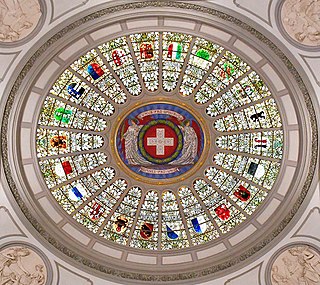
Each of the 26 modern cantons of Switzerland has an official flag and a coat of arms. The history of development of these designs spans the 13th to the 20th centuries.

The Old Swiss Confederacy began as a late medieval alliance between the communities of the valleys in the Central Alps, at the time part of the Holy Roman Empire, to facilitate the management of common interests such as free trade and to ensure the peace along the important trade routes through the mountains. The Hohenstaufen emperors had granted these valleys reichsfrei status in the early 13th century. As reichsfrei regions, the cantons of Uri, Schwyz, and Unterwalden were under the direct authority of the emperor without any intermediate liege lords and thus were largely autonomous.

Eidgenossenschaft is a German word specific to the political history of Switzerland. It means "oath commonwealth" or "oath alliance", in reference to the "eternal pacts" formed between the Eight Cantons of the Old Swiss Confederacy of the late medieval period. In Swiss historiography, this relates most notably to the Rütlischwur between the three founding cantons Uri, Schwyz and Unterwalden, which traditionally dates to 1307. In modern usage, Eidgenossenschaft is the German term used as an equivalent to "Confederation" in the official name of Switzerland, Schweizerische Eidgenossenschaft. Its corresponding adjective, eidgenössisch—officially translated as "Swiss federal"—is used in the name of organisations such as the Eidgenössische Technische Hochschule, or Swiss Federal Institute of Technology. The term Eidgenosse refers to individual members of the Eidgenossenschaft. It is attested as early as 1315 in the Pact of Brunnen, referring to the cantons of Uri, Schwyz and Unterwalden. The abstract noun Eidgenossenschaft is attested in the 15th century. In modern usage, Eidgenosse is sometimes used in archaic or ironic usage for "Swiss citizen", especially for those citizens of purely Swiss origin and not from immigration.
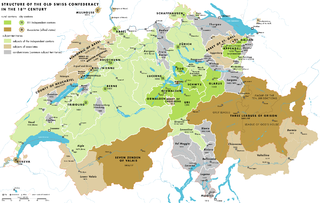
The early modern history of the Old Swiss Confederacy and its constituent Thirteen Cantons encompasses the time of the Thirty Years' War (1618–1648) until the French invasion of 1798.

The coat of arms of the Swiss Confederation shows the same white-on-red cross as the flag of Switzerland, but on a heraldic shield instead of the square field.

Waldstätte is a term which has been used since the early thirteenth century to refer to the Stätte, or later Ort or Stand of the early confederate allies of Uri, Schwyz and Unterwalden in today's Central Switzerland.

The Treaty of Basel of 22 September 1499 was an armistice following the Battle of Dornach, concluding the Swabian War, fought between the Swabian League and the Old Swiss Confederacy.

The Rütli Oath is the legendary oath taken at the foundation of the Old Swiss Confederacy by the representatives of the three founding cantons, Uri, Schwyz and Unterwalden. It is named after the site of the oath taking, the Rütli, a meadow above Lake Uri near Seelisberg. Recorded in Swiss historiography from the 15th century, the oath is notably featured in the 19th century play William Tell by Friedrich Schiller.
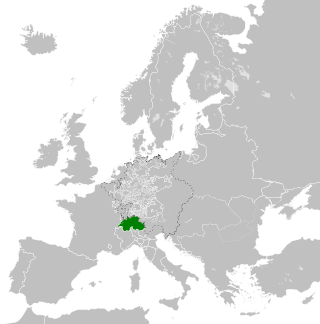
The Old Swiss Confederacy, also known as Switzerland or the Swiss Confederacy, was a loose confederation of independent small states, initially within the Holy Roman Empire. It is the precursor of the modern state of Switzerland.

The historiography of Switzerland is the study of the history of Switzerland.

Albrecht von Bonstetten was a Swiss humanist of the later 15th century. A member of the baronial von Bonstetten family, he entered Einsiedeln Abbey at a young age, and after studies in Fribourg and Basel he returned to Einsiedeln and was made deacon in 1469. He studied canon law at Pavia and was ordained a priest in 1474, and he received the title of doctor utriusque iuris from Emperor Maximilian in 1498. He published a biography on Nicholas of Flüe called Historia fratris Nicholai in 1479.
In legend and in the early historiography of Switzerland there is an account of a migration of a population of Swedes and Frisians settling in the Swiss Alps, specifically in Schwyz and in Hasli (Schwedensage).


















